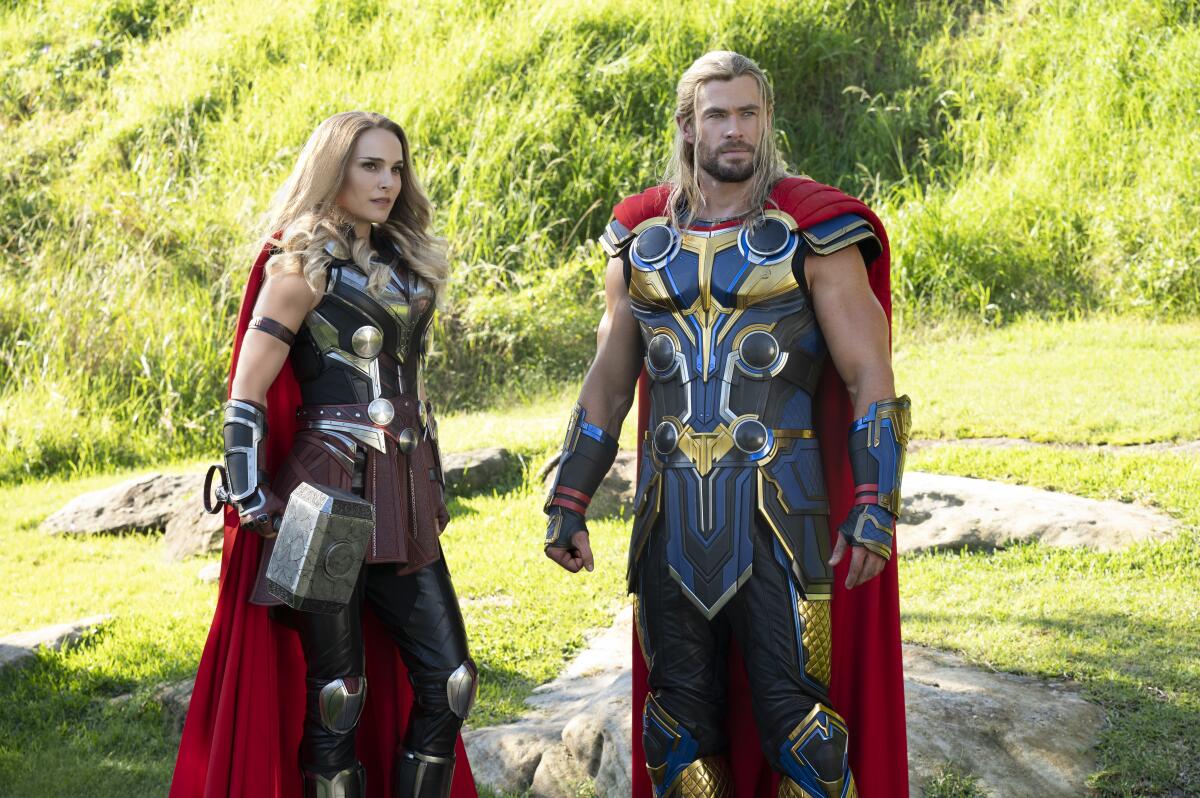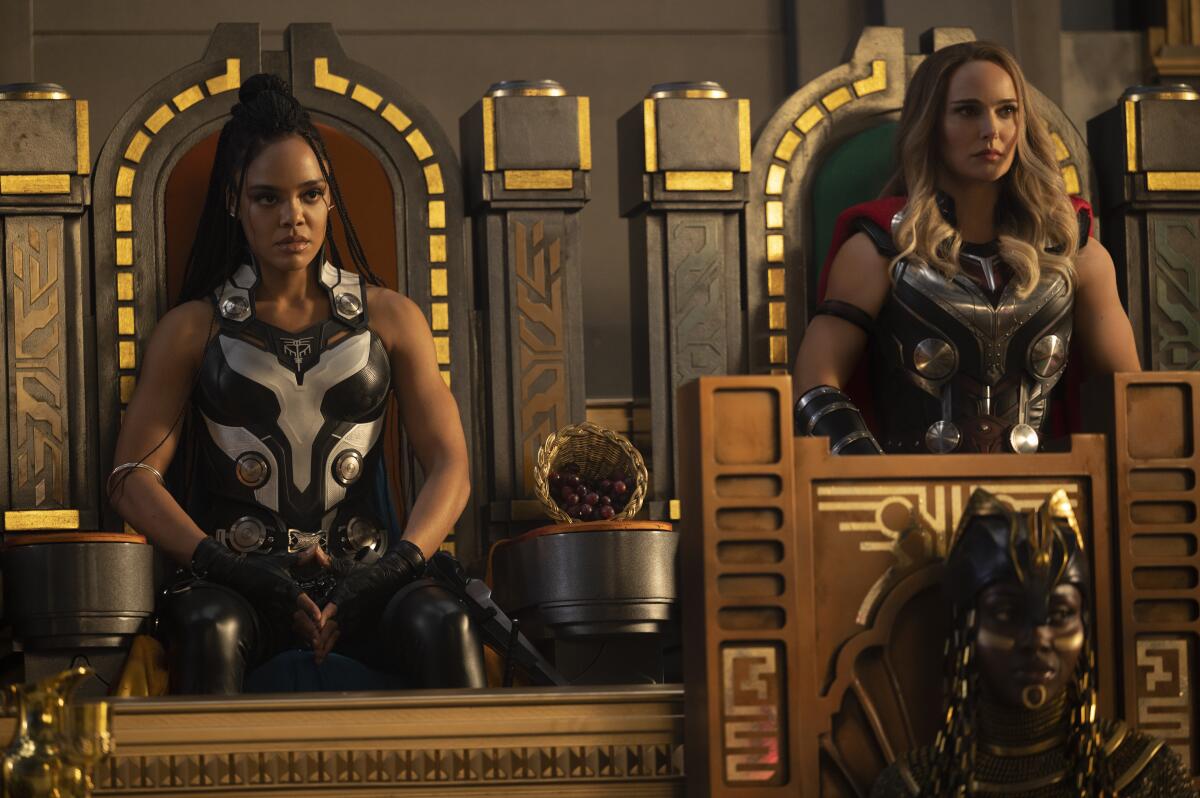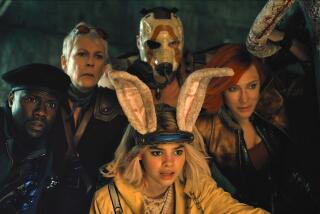Review: A not-so-mighty âThorâ sequel is painless but pointless

There are a few good things worth singling out in the otherwise not-very-good thing that is âThor: Love and Thunder.â First up are two large screaming goats, whose digitally amplified screeches are a comic gift that rarely stops giving. Christian Bale delivers a genuinely skin-crawling turn as a zombified villain named Gorr the God Butcher, who so closely resembles both Voldemort and âThe Nunâ that Warner Bros. might want to sue. And then thereâs the lovely, loony sight of Russell Crowe, gamely chassĂŠing in a golden breastplate and white tutu as the Greek god Zeus. Are you not entertained?
Still, the best thing about the movie, as far as I can tell, is its running time. To the 60-plus-hours of theatrical content that have so far rolled off the Disney/Marvel assembly line, this fourth Thor-centric caper adds a mostly painless if largely pointless 120 minutes. And that happily includes the closing credits, which fans will of course sit through in their entirety, dutifully enduring the names of visual-effects artists and crane operators in exchange for a glimpse of future Marvel superheroics. Minding the usual anti-spoiler entreaties, I can disclose that at the very end â right after [redacted] arrives at [redacted] and speaks to [redacted] â a title card pops up with some reassuring if not exactly surprising news: âTHOR WILL RETURN.â
For your safety
The Times is committed to reviewing theatrical film releases during the COVID-19 pandemic. Because moviegoing carries risks during this time, we remind readers to follow health and safety guidelines as outlined by the CDC and local health officials.
Thank God (or gods). But here arises some confusion. By âThor,â Iâm pretty sure the movie means the majestically mulleted Norse deity Thor Odinson, played as ever by Chris Hemsworth with such genial charm that even his biceps seem to be smiling at you. But as youâve doubtless heard, âLove and Thunderâ features another aspirant to the Thor mantle. That would be Dr. Jane Foster (Natalie Portman), leading American astrophysicist and Thorâs mortal soulmate from âThorâ (2011) and âThor: The Dark Worldâ (2013). In this movie, as in the Jason Aaron-penned comic-book volumes from which it draws inspiration, Jane has stage IV cancer â a near-certain death sentence that also brings about her unexpected transformation into her own blond-tipped, red-caped superhero, known as the Mighty Thor.
Jane achieves this by wielding Thorâs old hammer MjĂślnir, which was smashed to smithereens in âThor: Ragnarokâ (2017) and briefly resurrected amid the time-traveling schemes of âAvengers: Endgameâ (2019). Now firmly out of retirement, MjĂślnir lives to bludgeon and boomerang again in âLove and Thunder,â and also to stir up some amusing jealousy issues where Thorâs new weapon, Stormbreaker, is concerned. Itâs a battle of axes and exes, one that seeks to put Thorâs massive ego in check, give the franchise a gender-parity upgrade and renew some long-dormant romantic-comedy sparks.

Unfortunately those aims are lost, or at least frustratingly under-realized, in a blur of flat-footed jokes and lazily schematic plot turns, plus the general sense of a franchise spinning its creative wheels. These issues smack of run-of-the-mill Marvel fatigue, but they also bear the fingerprints of New Zealand-born director Taika Waititi (who co-wrote the script with Jennifer Kaytin Robinson). Having set Thor on a looser, goofier trajectory in âRagnarok,â Waititi tries to extend that movieâs breezy comic tone into an adventure that strives to be both sillier and sadder. He wants to treat Thor as a figure of fun but also to restore to him a dimension of the pop-cultural grandeur that no Avenger, even a retired Avenger, can do without for long.
And so the movie tries to both mock and burnish Thorâs legend with a series of zippy once-upon-a-time montages that recap the characterâs ups and downs, his losses (Loki!) and loves (Jane, among others), and his unusual number of physical makeovers, from âRagnarokâsâ dashing textured-crop-and-eyepatch look to that âEndgameâ-era beer belly. Itâs enjoyable for a while to relive all this. Thorâs sometimes rudderless evolution over the years speaks to the trickiness of a character that even the well-oiled Marvel machinery hasnât always been able to crack. It also speaks to the sustaining warmth and versatility of Hemsworthâs star presence, his ability to remain good company even when the movies themselves havenât been good.
As this latest gets under way, Thor has recovered his enviable god-bod but still has little sense of purpose. The problem with âLove and Thunderâ is that it seems to reflect this identity crisis while pretending to solve it. The story begins to splutter with some perfunctory, poorly executed scenes of Thor tagging along with the Guardians of the Galaxy, allowing Chris Pratt, David Bautista, Karen Gillan and others to cash a quick paycheck. Things improve a bit once the action shifts to New Asgard, the bucolic Norwegian town/tourist trap where Thorâs fellow surviving Asgardians have relocated, but even here, the action bogs down in look-at-who-we-got cameos and product placements that are sometimes disguised as jokes about product placements.
All this comic riffery is par for the course for Waititi, whose famously impish humor has made him a popular fit for a risk-averse franchise that rewards personality over personal vision. But his wannabe-breezy comedy has always struck me as awfully strenuous, and the Marvel enterprise seems to encourage his worst instincts; too often he mistakes sloppiness for irreverence and self-satisfaction for self-mockery. Sometimes his comic instincts do pay off, as when Thor, Jane and friends crash a neo-Olympian, Vegas-ready paradise called Omnipotence City, where Croweâs Zeus preens, prances and speaks in a hilariously awful Greek accent. But the movie is considerably better in those infrequent moments when it strives for sincere, unironic emotion, whether itâs relaying the tragedy that gives rise to Gorrâs murderous reign of terror or exploring Janeâs struggle to evade her own mortality.
That lends a certain poignancy to Janeâs transformations into the Mighty Thor, which, far from healing her, only hasten her cancerâs spread. But none of it makes her an interesting or credible superhero, a liability that the movie tries to milk for bumbling comic relief. Thereâs nothing inherently interesting about putting a character â or an actor as good as Portman â in a cape and helmet, and itâs frankly depressing to see brainy scientist Jane reduced to a hammer-throwing catchphrase machine. Tessa Thompson fares rather better as Thorâs ally and New Asgardâs ruler, Valkyrie, but sheâs still needlessly sidelined here, almost as if two prominent women warriors were too much for the movie to handle.
It does, admittedly, try to handle a lot. âThor: Love and Thunderâ has bright, psychedelic colors and heavy-metal-inspired typefaces, but also a near-horror interlude shot in ghostly black-and-white. It has unmemorable slicey-dicey action scenes and a friendly rock-like sidekick named Korg (voiced by Waititi himself). It has at least two moviesâ worth of thudding Guns Nâ Roses needle drops, including âWelcome to the Jungle,â âParadise Cityâ and âSweet Child Oâ Mine.â Speaking of which: The movie has children, lots of children, who are placed in terrible danger when the deranged Gorr decides to become the Pied Piper of New Asgard.
Waititi has a long-standing affinity for young characters, whether heâs making a charmer like âHunt for the Wilderpeopleâ or a meretricious clunker like âJojo Rabbit.â No imaginary Hitlers pop up in âThor: Love and Thunderâ (which, come to think of it, might be the actual best thing about it), but Waititiâs deployment of children here feels both characteristically strategic and irritatingly cynical. The kids raise the stakes, cutesify the story and put a lump in your throat, as kids in movies tend to do. They also sentimentalize Thor in ways that make the inevitable sequel feel, at this stage, like a singularly unappealing prospect.
'Thor: Love and Thunder'
Rating: PG-13, for intense sequences of sci-fi violence and action, language, some suggestive material and partial nudity
Running time: 2 hours
Playing: Starts July 8 in general release
More to Read
Only good movies
Get the Indie Focus newsletter, Mark Olsen's weekly guide to the world of cinema.
You may occasionally receive promotional content from the Los Angeles Times.









